How CDs help fight distracted listening
The Moondrop Discdream 2 Ultra CD player is my favorite new thing.
I went to the CES consumer electronics show in Las Vegas in January and, while the show is less about audio gear than it used to be, I was most impressed by the $350 Moondrop Discdream 2 Ultra portable CD player.
It’s a beautiful piece of gear, one that evokes the classic sharp corners and machined aluminum cases that defined Japanese audio gear in the ’80s. Moondrop’s engineers have designed a unit that evokes all the magic that people felt when they finally had an alternative to their noisy LPs and finicky turntables.
For all the romance that vinyl evokes today, people were pretty sick of it back in the day and many were even embracing cassette hiss as an alternative to LPs before CDs took over the market.
I’ve also been enjoying a $180 FiiO DM-13 portable CD player with Bluetooth, a unit that has a lot more in common with the Moondrop than you might imagine. I’ve also got a couple of vintage Philips portable CD players and compared all four.
CD players are due for a comeback, but there’s a lot of manufacturing expertise that’s been lost in the past two decades. In some important ways, new CD players are less advanced than what you could buy at the CVS twenty years ago. When it comes to versatility, these new players represent a big improvement.
Anyone who’s trying to write about audio gear right now has to decide how to approach the tariff chaos. I’ve decided to write about gear and publish with the current prices as they stand today. Just know that those prices may go up or down in the coming weeks or months based on the whims of the U.S. government.
If you’re interested in the FiiO CD player (or their excellent $90 CP13 Walkman-style cassette player, a unit I’ll be writing about soon), know that FiiO has announced that they’re planning to raise U.S. prices by 40% on May 1st if the tariff situation doesn’t resolve itself.
Hook addiction syndrome
I have some long-term listening damage from my publisher and A&R careers. My actual hearing is remarkably intact after a lifetime of abuse and too many shows without earplugs. What haunts me is the impatience I picked up when listening to thousands upon thousands of demo tapes.
Back when I started, any creative executive’s first purchase on the company dime was a high-end cassette deck with a music search function. That bit of ancient technology would find the next silence gap on a tape so you could skip to the next song. When plowing through a stack of tapes, you’d put aside the ones that caught your ear, but let’s be honest. Few songs lasted past the first 60 seconds of listening.
I think a lot of bands would expect an apology at this point, but it comes down to this: There are remarkably few artists who got discovered in the slush pile. It was usually a manager or an attorney or a scout or a booking agent or a record store owner or a producer who hipped the label to a promising act. We all knew that the act had already been vetted to some degree, so we were willing to invest more of our limited attention on something that someone else believed in enough to share.
The flip of that equation is the people who brought us too many bad acts lost their skip-the-line privileges. That system worked reasonably well for a long time.
We could talk about the undiscovered bands that were missed because of those practices, but people who worked at the labels would counter that an act without a support structure in place never have a chance anyway. That’s a complicated discussion for another time.
The rise of demo CDs were a boon because a remote control let you skip to the next track almost immediately. No one had to wait for the cassette deck to fast forward to the next song. Figuring out which demos were a pass became a much more efficient operation.
I realize this working method will outrage in some of you, but you should also accept that there weren’t many A&R executives who ever spent a day going through the slush pile. Most of them just ignored it altogether. Sometimes an intern was given a pile of tapes and asked to bring back anything interesting, but woe to the sincere kid who tried to hype an act that was never going to get a deal.
Some labels decided that they wouldn’t accept unsolicited demos at all after enterprising litigators decided to sue acts for “stealing” songs because a demo had been submitted to an A&R exec, floating the idea that the record company person must have heard the song and played it for the artist.
That’s hilarious.
That’s how I accidentally rewired my brain: Too many hours listening to music that I often didn’t want to hear. The reprogramming probably started when I was Music Director at WHRB and had to go through stacks of new LP releases and eventually resorted to needle drops to weed out the chaff.
(Talk to a good college radio person from the ’70s or ’80s and many of them will claim that they can identify the chorus on a new record by the groove pattern in the vinyl. I may be out of practice, but I’m sure this was a real skill.)
I’ve recently started listened to CDs without a remote control in an effort to play albums all the way through without distraction. I’m trying to undo some of the damage that led me to impatiently hunt for the immediate dopamine hit I needed when programming a radio station or looking for bands to sign.
Of course, now Spotify has allowed everyone to develop similar bad habits. People skip tracks or listen to computer-generated playlists without really making a connection to the music. I’m here as a long-term survivor to share the ways I’ve learned to combat the mindless surfing that music listening has become.
No crackles, no pops
CDs are as good as vinyl for focusing my listening, and the good news is that used ones are plentiful and you generally don’t have to worry about condition when shopping in the bargain bins.
Of course, you need a way to play them.
When you buy a CD player, you’re paying for the mechanism that spins the disc and the DAC chip that converts the digital data into an analog signal for playback. If it’s a boombox or portable CD player with a headphone jack, there’s also a built-in amplifier to power the speakers or headphones.
It’s the quality of those components that should determine the price. At the very top end of the CD market, manufacturers will tell you that noise from mechanical spinning will interfere with the DAC chip and that you should have a separate transport (laser and rotation only) that sends a digital signal to a freestanding DAC for highest quality. You can easily spend $10K on a setup if you go this route, but most people have better ways to spend their money.
Let’s revisit: Compact discs store music as digital files that have to be converted to analog signals for playback. That makes the audio quality incredibly consistent, but cassette and vinyl romantics think the digital stage robs music of its soul.
The truth is there’s almost infinite variation in sound quality with analog formats. Individually stamped LPs are going to have different groove depths and, no matter how many precautions a manufacturer may take, every machine that duplicates tapes is going to have variations in speed. That’s not counting the quality of the needle or tapeheads on playback devices or the damage brought on my normal wear-and-tear every time you play an LP or tape.
Physical digital media is a far more stable physical format (even after you allow for the tales about disc rot), and I’m in the camp that you can get more consistent digital data than streaming can deliver.
CDs can be awesome if you have the right signal path.
A standalone component CD player is basically a DAC, a transport mechanism to spin the disc, and a power supply. If you’re using a portable CD player, add in an amplifier to power the analog signal to headphones or external passive speakers.
The most important factor in the CD equation is the DAC. You need a chip that’s going to do the best analog conversion possible. There are plenty of players that list for $5K and up, including a few that sell for as much as $50K.
Manufacturers who work in the stratosphere will tell you that the quality of the motor that spins the disk and the power supply (plus the internal clock) of the gear are equally important, but you’re not going to hear a difference unless your overall system costs hundreds of thousands of dollars.
For almost anyone reading this, you just need to make sure you’ve got a good DAC. If you disagree with that statement, you really should be reading The Absolute Sound for your audio recommendations instead of me.
CD players have become a niche market, so there aren’t many decent options for an all-in-one unit under $1,000. I like the$399 Cambridge Audio AXA35 and AXC35, but I think there are better ways to approach this if you’re on a budget.
The thrift store solution has been to buy a used DVD player and to buy a cheap programmable remote if your $9 used player didn’t come with one (because they almost never do). Unfortunately, the DAC chips in inexpensive DVD players are usually just as bad or worse than the one in your computer.
The trick is to find a DVD or Blu-ray player with an optical output so you can bypass the built-in DAC and use your own. That won’t necessarily lead to clean lines on your audio shelves and, to be fair, most of the early 21st century DVD players look incredibly cheap.
That leads us back to the Moondrop Discdream 2 Ultra and the FiiO DM13. They’re both better looking than a crusty old DVD player, and each can do double duty as a portable player.
Moondrop Discdream 2 Ultra

The machined aluminum body accounts for a lot of the Moondrop’s higher price, but there’s also the excellent ESS ES9281AC Pro DAC. Not only does this unit do a great job with standard CD Red Book 16-bit/44.1kHz CD playback, it can also handle PCM audio up to 32-bit/384kHz and DSD256 through its USB-C port. That means you can use it for higher-resolution streamer playback from your computer or phone.
In addition to the standard 3.5mm headphone jack, there’s a balanced 4.4mm output for anyone into higher-end IEMs. Moondrop rates the amplifier at 300mW at 32 ohms, an impressive amount of power for a portable CD player. They also promise 10 hours of battery life, and I’ve found that to be a realistic number.
The aluminum adds some bulk. Moondrop says it weight just under a pound but it feels more solid and a bit heavier than that. Maybe it’s the materials, maybe it’s the sharp corners of the unit that give the impression that it’s larger. The metal buttons on the front of the are huge and very clicky. They’re very much a throwback to mid-century industrial gear even more than to the era’s electronic components. I love them.
Here’s my favorite thing about the Moondrop, a feature that didn’t exist with an earlier generation’s portable CD players: You can plug in an optical cable to bypass the internal DAC and amplifier, which makes the Discdream 2 Ultra an attractive and effective CD transport that you can run through a better quality DAC and amplifier to your home audio system.
There’s no way to bypass the amplifier while still using this unit’s DAC, so you’ll need an external DAC if you want to plug it into a home audio system. I’ve tested it with both my iFi NEO iDSD desktop unit (I have the original model, but here’s a link to version 2) and the WiiM Pro Plus DAC and streaming box on a home system.
The unit looks great and the fact that it doesn’t come with a remote is a feature not a bug for me. I start a CD and I’m committed to listening all the way through unless I want to get up and walk across the room to pause it.
There’s a $30 protective sleeve if you want to use this player for travel. I’d make that investment if I was going to let this one leave my house.
FiiO DM13
The FiiO DM13 is quite a bit smaller than the Moondrop and its rounded corners make it easier to handle. The build quality isn’t quite as impressive, but the Moondrop is definitely making a statement with a case that’s over engineered for its task. That’s a purposeful design choice that I love, so please don’t take that as a diss on the Moondrop.
It’s just that the FiiO feels a bit more practical. FiiO used the ESS Sabre ES9018K2M DAC and gave the DM13 a 200mW at 32 ohms amplifier. The unit measures roughly 5.39 inches wide, 5.67 inches deep, and just about 1.08 inches thick and weighs 13.4 ounces.
The DM13 can also be used as a CD transport, with all of the same advantages that I described with the Moondrop Discdream 2 Ultra. There’s a FiiO-branded velvet bag that seems designed to work with this player, and I found one for around $11 shipped online. That’s not as good as a close-fitting sleeve or case, but you’ll want something to protect this if you travel with it. You might consider an old Crown Royal velvet bag, since it looks to be about the same size.
FiiO also added Bluetooth to the more expensive versions of this CD player, a connection that reduces sound quality compared to a wired connection but offers a lot of convenience if you want to listen to CDs while using your hands for something else.
You might be interested to hear that FiiO has added CD ripping capabilities to the DM13 but, while this technically works, it’s not a useful feature.
Ripping seems to work better with a USB-C thumb drive plugged into the player instead of plugging into a computer, but I expect that many of the computer users don’t realize that the FiiO DM13 requires a drive in the PC-friendly FAT-32 format. A Mac HD is not going to work, even though it will be able to read WAV files from a FAT-32 thumb drive if you decide to use one with the player.
Unfortunately, the DM13 can only do real-time rips. You’ll have to play the disc all the way through to generate those audio files.
The best way to make CD-quality rips is to buy a cheap external DVD drive and drag the songs from the CD onto your computer. You can use software like Audacity to add basic metadata or convert the WAV files to FLAC or ALAC if you want more comprehensive information embedded in your files. Raise your hands in the comments if you’d like me to revisit this topic in detail.
A throwback comparison
The Moondrop and the FiiO CD players are not slim, pocket-sized units. They’re much bulkier than the portable CD players you might remember from the turn of the century. The factories that made those sleek units shut down long ago and the machines that built them were sold for scrap. The portable audio player market is now a niche, and no one can afford to go back and rebuild the old machinery for a limited market.
If this is an interesting topic, The Verge made an excellent video on the topic: "Why are cassette and CD players so bulky now?”
I decided to compare the Moondrop and the FiiO to some old Philips CD players I have lying around. After whatever I’d been using before broke, I bought a Philips AZ7901 at a FNAC store in Paris in 2003 and apparently got very lucky. That unit sounds amazing, with a fantastic DAC that’s got more depth in the low end than either the Moondrop or the FiiO players.
It’s barely larger than a CD, and so is the Philips AX2312/17 that I also own. That one also sounds good, but not as good as either of the new units I’ve been testing. Neither of the Philips players is especially well-built, but they are much smaller than the Moondrop and FiiO.
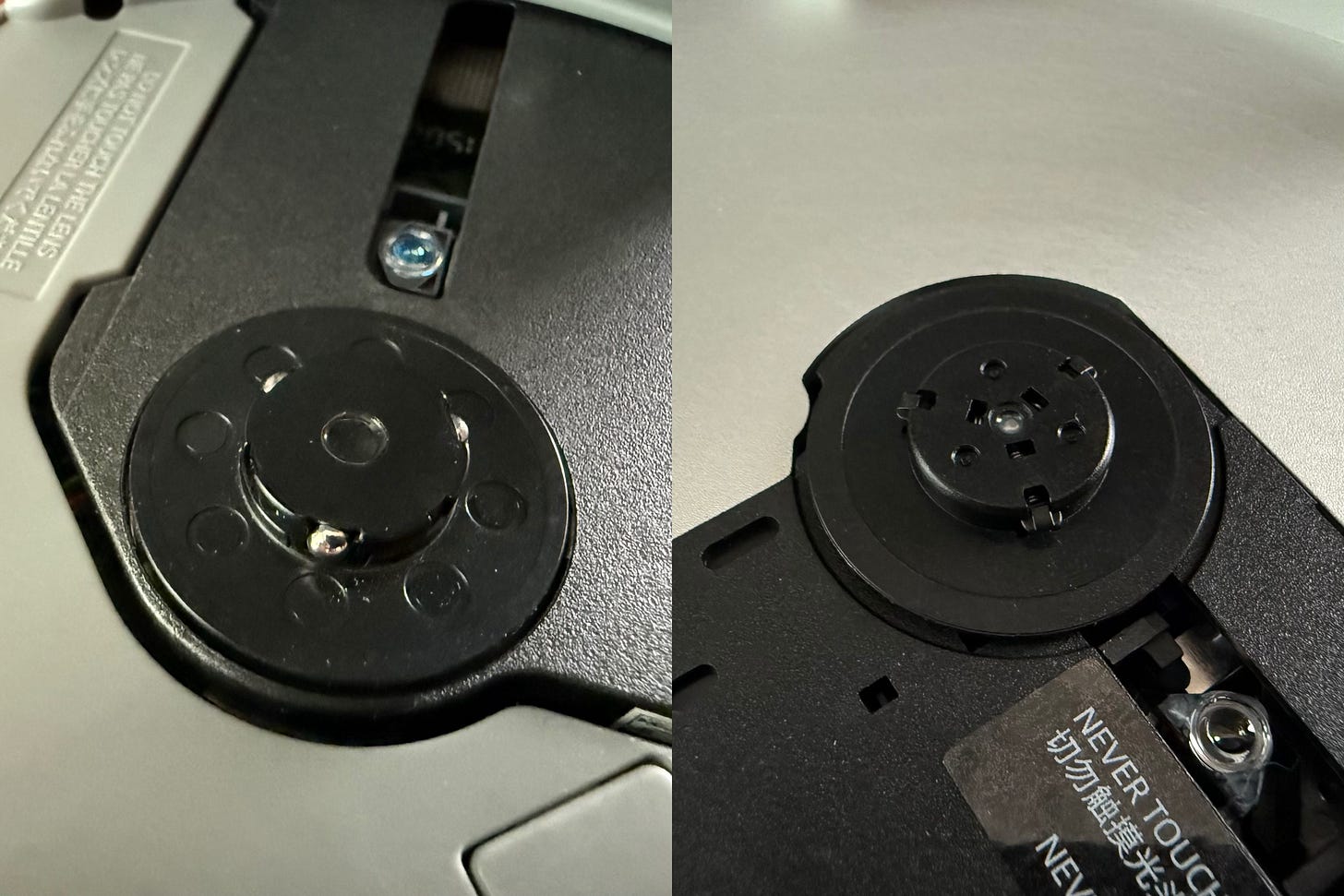
Both the Moondrop and the FiiO seem to be using the same laser/transport unit, and they hold the disc in place with some plastic posts, parts that are certain to wear out at some point in the future. The vintage Philips units swap those plastic posts for durable ball bearings. Considering the manufacturing challenges detailed in the Verge video, it’s not fair to ding anyone who’s trying to make a new CD player for the limited parts available in 2025.
While these old CD players are incredibly well designed and sound really good, they do have their limitations. These were designed to power passive earbuds, so you’re locked in to using the built-in DAC and amp. Plugging these into a home audio system is not going to yield great results.
It’s the versatility that makes these new CD players so attractive. I’m really enjoying using both units plugged into an external DAC and using them on my desktop or with a bedroom system.
The fact that there’s no remote means that I start a disc and have to let it play through, a situation that I’ve decided is a feature instead of a bug. Choosing something to play becomes a conscious decision. I’ve dodged the imperfect streaming algorithm and I’ve got to give every song a chance instead of skipping if I’m not engaged in the first 20 seconds. This is a plus for me.
CDs are still cheap, but the used market is finally starting to come back to life. If you’re willing to hit record shops and thrift stores in person, there are still a lot of bargains out there.
The ethics of used CDs
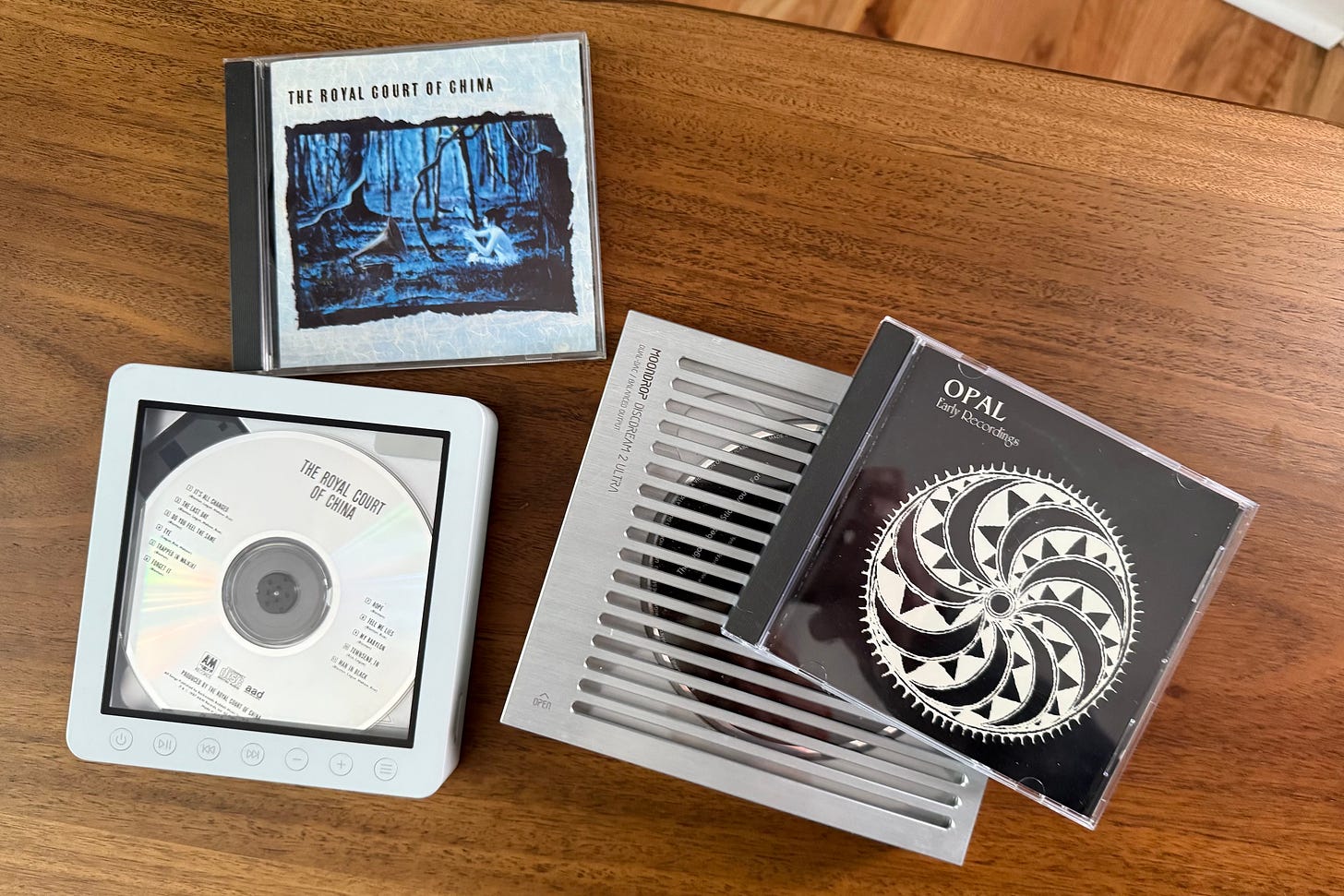
I have to remind everyone that no artist or songwriter gets paid when you buy a used LP, CD, cassette, or 8-track tape. This is an ethical dilemma that has dogged the business for as long as there has been physical media. Back when everyone was selling millions of copies, the used market was an afterthought and didn’t have much impact on an artist’s bottom line.
Now there aren’t so many physical sales and artists aren’t earning much from streaming. The other part of this equation is that very few independent record stores could stay open if the used music business didn’t subsidize the tiny margins they make on new releases.
Buying used copies in a record store supports the music ecosystem. Buying used vinyl at a thrift store may or may not support a worthy cause. If you buy something used and discover you really love it, consider buying some merch or digital tracks from Bandcamp to put money in the artist’s pocket. If you discover music from an artist who’s no longer active, spend your money with an up-and-coming artist who could use the support.
There’s no simple way to navigate this problem. Figure it out for yourself as best as you can. People who make music deserve to earn a living, but so do the people who help make that music available for us to enjoy.
I spent an outrageous amount of money on a sealed copy of a ’60s LP at the AXPONA audio show a couple of weeks ago. The artist never got paid the way he should have during his lifetime, but I bought it from a rare records dealer who’s got an incredible stock of records that are nearly impossible to find. I’m glad I supported his business even if wasn’t supporting the artist.






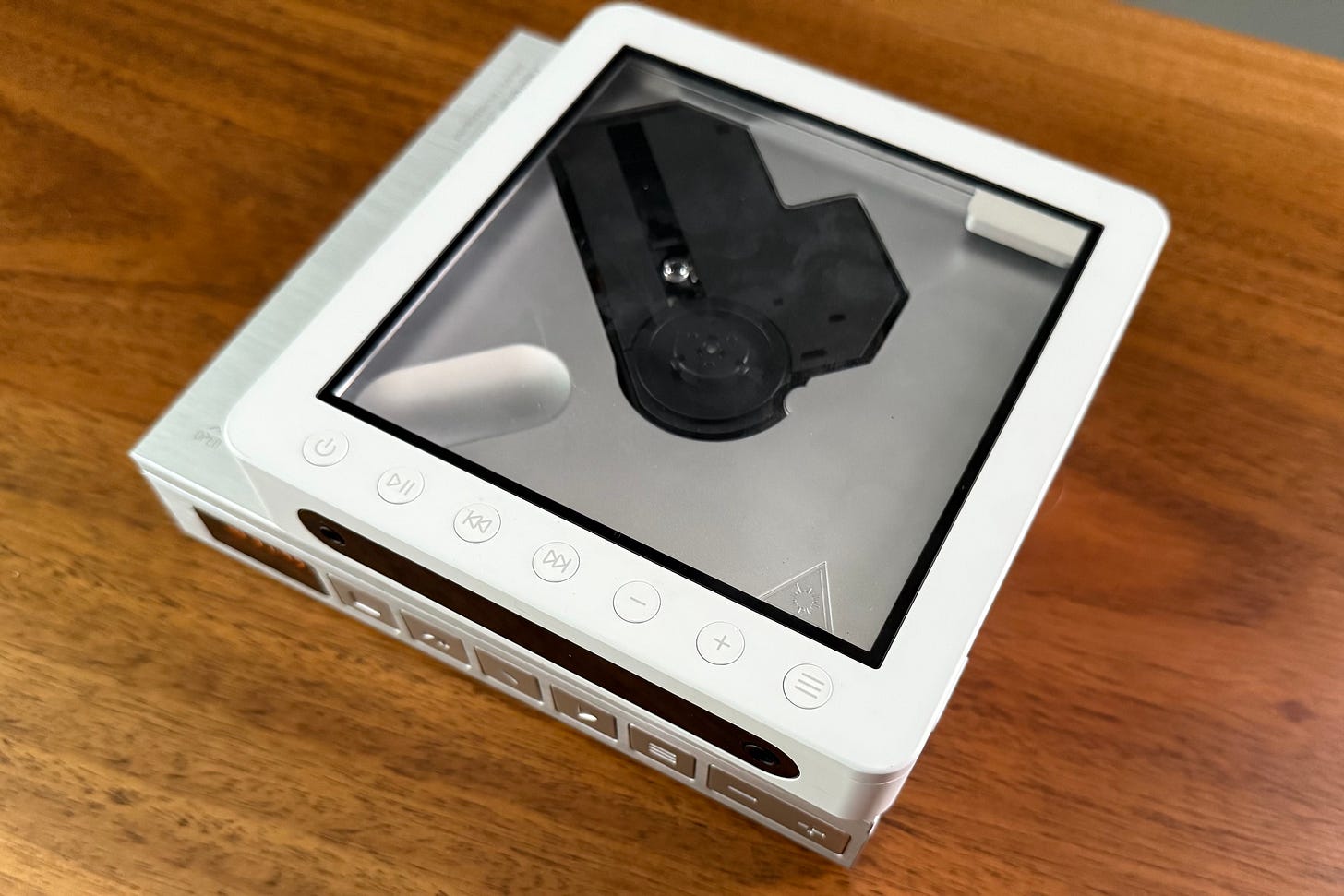
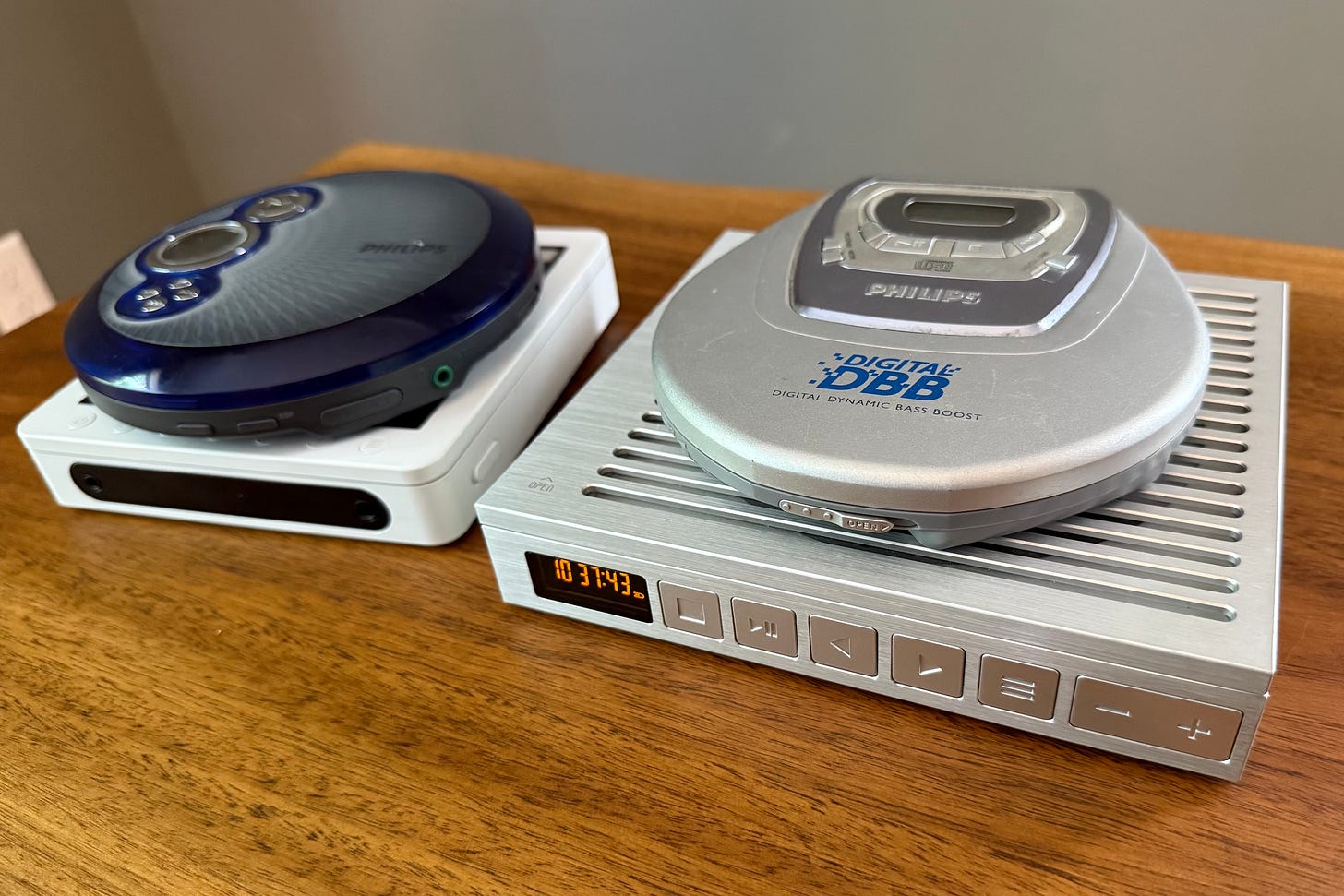
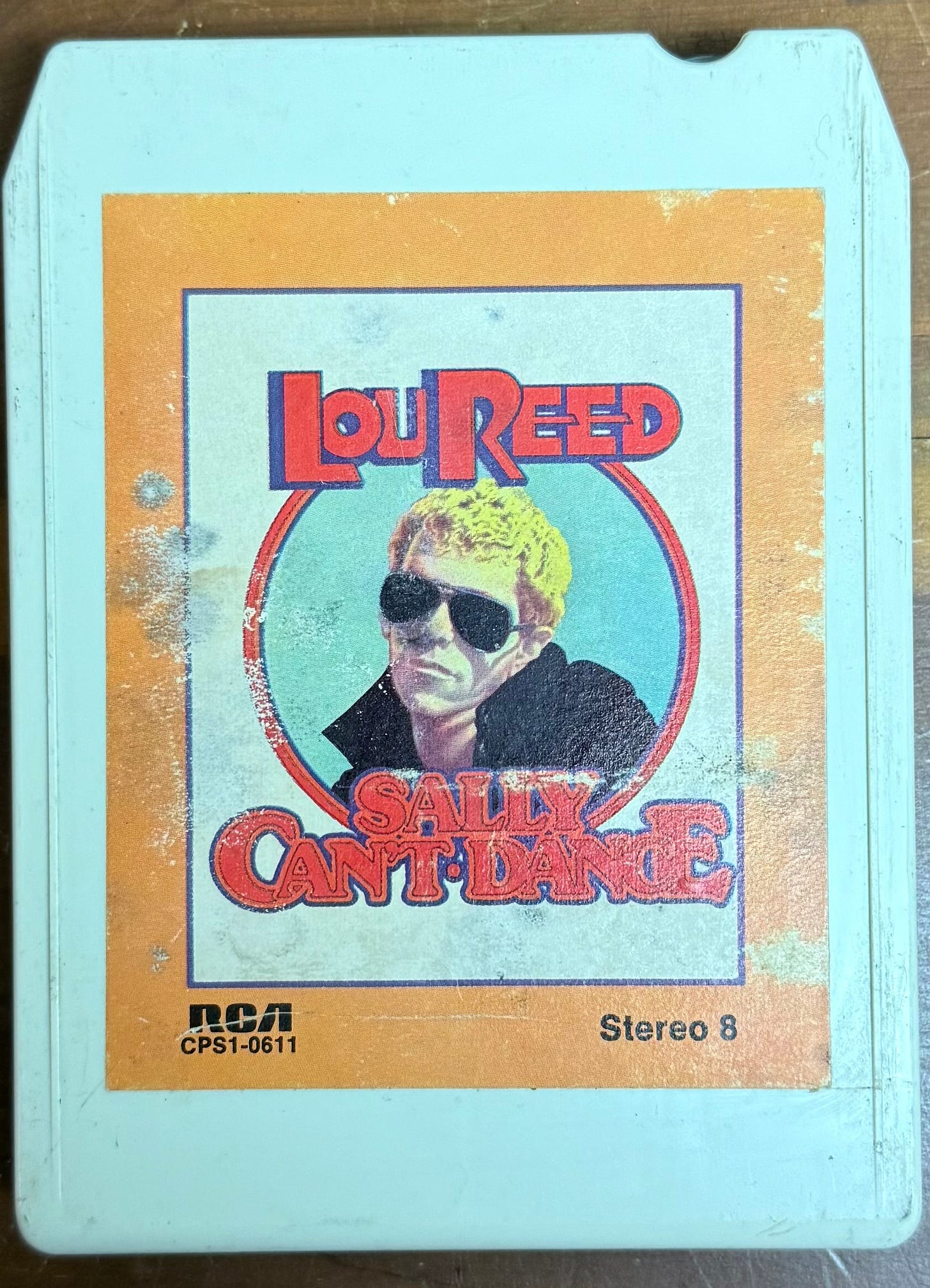
Really interesting article. Since I was born in 1976, I was introduced to music at a young age when my parents were transitioning from vinyl records to cassettes. My mom still has the "books on record" kids' stories on a Fisher-Price record player that played 45s in her basement (I broke it out about 7-8 years ago when my own kids were younger and they loved listening to the "Gremlins" movie on record)!
By 1985 or so, in my house anyway, vinyl gave way completely to cassettes. I didn't really get into music until 1986/87 and I got a boom box for Christmas in December 1986. The first cassette I bought with my own money (and still the best one ever made IMHO) was U2's "The Joshua Tree." But cassettes, for me, were short-lived. I got my first CD player in 1990 or 1991 and that changed everything. My owns kids can't fathom how great CDs were coming on the back of cassettes or vinyl (which, as you said, didn't have any romantic connotations in 1985 but only complaints about scratching, how unwieldy it was, etc.). The ability to skip to any track was magical.
As an aside, I also got caught up in the digital music phenomenon. I finally got tired of moving my 1000+ CDs during my last move in 2019 (and got tired of my wife asking why I kept all of them) so I sent most of them to a third party who ripped them into Apple Lossless format. It was an excellent decision and I have only occasionally regretted not keeping the CDs.
In any case, I think because I grew up in an era when it wasn't easy to skip songs, for my entire life I have appreciated albums more than just songs. Today, when I listen to The Joshua Tree, I usually listen to the entire thing. When I listen to Guns N' Roses Use Your Illusion II, I play it straight through. When the Cure released Songs of a Lost World last year (and, yes, I'm buying vinyl), I threw it on the turntable and listened straight through. I've listened to it about 100 times by now and still do it this way.
This article struck a chord with me because, while I don't think I will ever go back to CDs since they never held any romantic appeal for me and, to my ear, don't sound any better than Apple Lossless formats, I understand the feeling of people who might yearn for them. My daughters, ages 15 and 13, never had anything but digital music but they are the ones who have led the vinyl renaissance in our house. I think they were missing what I had as a kid: that tangible connection with an artist. Although the CD format itself I think has been surpassed by streaming (loosely defined), what is missing is the physical aspect. Nothing today compares to buying the Smashing Pumpkins "Aeroplane Flies High" box set or Queensryche "Operation: LIVEcrime." Nothing, that is, except vinyl. My 13-year-old daughter is vying for the title of the world's most dedicated Swiftie and has has all her vinyls, including some special editions, presumably because she was looking for that inexplainable connection to the artist that only physical media can provide.
In any case, these articles are fascinating and I really appreciate them. Oh, and by the way, to listen to all my new vinyl records, I listen on the Spindeck MAX and Spinbase Max which you recommended in the very first Substack of yours I read following your appearance on Rick Beato's YouTube.
“very few independent record stores could stay open if the used music business didn’t subsidize the tiny margins they make on new releases.”
Can you explain this? I don’t understand.